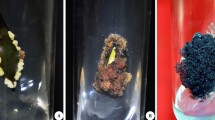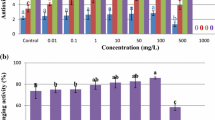Abstract
Ipomoea turbinata Lagasca and Segura (Purple Moonflower) belongs to the largest flowering genus Ipomoea in the Convolvulaceae family. Ipomoea turbinata has not been previously explored for its in vitro potential. This is the first study focused on thidiazuron-induced callus culture for efficient biosynthesis of commercially important phenolic compounds in this plant species. Among the two plant growth regulators tested on leaf, stem, and root explants, 5 mg L−1 thidiazuron (TDZ) induced the highest biomass accumulation (61.4 g L−1 fresh weight, 6.3 g L−1 dry weight) in leaf-derived callus cultures after 5 wk of culture. The highest total phenolic and flavonoid contents recorded were 9.04 mg g−1 and 1.16 mg g−1, respectively, in optimized callus cultures. High-performance liquid chromatography analysis indicated high levels of pharmacologically important anticancer compounds such as chlorogenic acid (13.48 mg g−1), arctigenin (11.67 mg g−1), quercetin (6.19 mg g−1), and kaempferol (5.48 mg g−1), along with other phenolic acids. Furthermore, the antioxidant activity was also evaluated, and leaf-derived callus culture displayed a maximum of 62.6% antioxidant potential. The induction of improved biomass accumulation in callus culture and the production of multipotent bioactive metabolites shows the potential of the multifunctional thidiazuron hormone as an efficient elicitation tool in callus culture of I. turbinata.






Similar content being viewed by others
References
Ahmad N, Fazal H, Ahmad I, Abbasi BH (2012) Free radical scavenging (DPPH) potential in nine Mentha species. Toxicol Ind Health 28:83–89
Alam I, Sharmin SA, Naher K, Alam J, Anisuzzaman M, Alam MF (2010) Effect of Growth Regulators on Meristem Culture and Plantlet Establishment in Sweet Potato ['Ipomoea Batatas'(L.) Lam.]. Plant Omics 3:35–39
Ali M, Abbasi BH (2014) Thidiazuron-induced changes in biomass parameters, total phenolic content, and antioxidant activity in callus cultures of Artemisia absinthium L. Appl Biochem Biotechnol 172:2363–2376
Amarowicz R, Pegg R, Rahimi-Moghaddam P, Barl B, Weil J (2004) Free-radical scavenging capacity and antioxidant activity of selected plant species from the Canadian prairies. Food Chem 84:551–562
Arinaitwe G, Rubaihayo P, Magambo M (2000) Proliferation rate effects of cytokinins on banana (Musa spp.) cultivars. Sci Hortic 86:13–21
Awale S, Lu J, Kalauni SK, Kurashima Y, Tezuka Y, Kadota S, Esumi H (2006) Identification of arctigenin as an antitumor agent having the ability to eliminate the tolerance of cancer cells to nutrient starvation. Cancer Res 66:1751–1757
Blando F, Gerardi C, Nicoletti I (2004) Sour cherry (Prunus cerasus L) anthocyanins as ingredients for functional foods. Biomed Res Int 2004:253–258
Chandler J, Munson R, Vaughan C (1977) Purple moonflower: emergence, growth, reproduction. Weed Sci 25:163–167
Cheruvathur MK, Abraham J, Thomas TD (2015) In vitro micropropagation and flowering in Ipomoea sepiaria Roxb. An important ethanomedicinal plant. Asian Pac J Reprod 4:49–53
Curtin C, Zhang W, Franco C (2003) Manipulating anthocyanin composition in Vitis vinifera suspension cultures by elicitation with jasmonic acid and light irradiation. Biotechnol Lett 25:1131–1135
Fresco P, Borges F, Marques M, Diniz C (2010) The anticancer properties of dietary polyphenols and its relation with apoptosis. Curr Pharma Des 16:114–134
Gill SS, Tuteja N (2010) Reactive oxygen species and antioxidant machinery in abiotic stress tolerance in crop plants. Plant Physiol Biochem 48:909–930
Gunn CR (1969) History and taxonomy of the purple moonflower, Ipomoea turbinata Lagasca y Segura. Proc Assoc Official Seed Analysts North Am 59:116–123
Guo B, Abbasi BH, Zeb A, Xu L, Wei Y (2011) Thidiazuron: a multi-dimensional plant growth regulator. Afr J Biotechnol 10:8984–9000
Hämäläinen M, Nieminen R, Vuorela P, Heinonen M, Moilanen E (2007) Anti-inflammatory effects of flavonoids: genistein, kaempferol, quercetin, and daidzein inhibit STAT-1 and NF-κB activations, whereas flavone, isorhamnetin, naringenin, and pelargonidin inhibit only NF-κB activation along with their inhibitory effect on iNOS expression and NO production in activated macrophages. Mediat Inflamm 2007:45673. https://doi.org/10.1155/2007/45673
Han X, Shen T, Lou H (2007) Dietary polyphenols and their biological significance. Int J Mol Sci 8:950–988
Han Y-H, Kee J-Y, Kim D-S, J-g M, Jeong M-Y, Park S-H, Choi B-M, Park S-J, Kim H-J, Um J-Y (2016) Arctigenin inhibits lung metastasis of colorectal cancer by regulating cell viability and metastatic phenotypes. Molecules 21:1135. https://doi.org/10.3390/molecules21091135
Hayashi K, Narutaki K, Nagaoka Y, Hayashi T, Uesato S (2010) Therapeutic effect of arctiin and arctigenin in immunocompetent and immunocompromised mice infected with influenza A virus. Biol Pharm Bull 33:1199–1205
Hiroyuki H, Kousuke H, Eiji N, Mariko O, Yoshihito K, Setsuro H, Takeshi K (2002) Enhanced anthocyanin production from grape callus in an air-lift type bioreactor using a viscous additive-supplemented medium. J Biosci Bioeng 94:135–139
Huang M-T, Smart RC, Wong C-Q, Conney AH (1988) Inhibitory effect of curcumin, chlorogenic acid, caffeic acid, and ferulic acid on tumor promotion in mouse skin by 12-O-tetradecanoylphorbol-13-acetate. Cancer Res 48:5941–5946
Huang S-L, Yu R-T, Gong J, Feng Y, Dai Y-L, Hu F, Hu Y-H, Tao Y-D, Leng Y (2012) Arctigenin, a natural compound, activates AMP-activated protein kinase via inhibition of mitochondria complex I and ameliorates metabolic disorders in ob/ob mice. Diabetologia 55:1469–1481
Kasote DM, Katyare SS, Hegde MV, Bae H (2015) Significance of antioxidant potential of plants and its relevance to therapeutic applications. Int J Biol Sci 11:982–991
Khan T, Abbasi BH, Khan MA, Shinwari ZK (2016) Differential effects of thidiazuron on production of anticancer phenolic compounds in callus cultures of Fagonia indica. Appl Biochem Biotechnol 179:46–58
Khan MZI, Zahra SS, Ahmed M, Fatima H, Mirza B, Haq I-U, Khan SU (2018) Polyphenolic profiling of Ipomoea carnea Jacq. by HPLC-DAD and its implications in oxidative stress and cancer. Nat Prod Res 33:2099–2104
Li D, Liu Q, Jia D, Dou D, Wang X, Kang T (2014) Protective effect of arctigenin against MPP+ and MPTP-induced neurotoxicity. Planta Med 80:48–55
Lin R-J, Chen C-Y, Lo W-L (2008) Cytotoxic activity of Ipomoea cairica. Nat Prod Res 22:747–753
Liu C-L, Wang J-M, Chu C-Y, Cheng M-T, Tseng T-H (2002) In vivo protective effect of protocatechuic acid on tert-butyl hydroperoxide-induced rat hepatotoxicity. Food Chem Toxicol 40:635–641
Loke WM, Proudfoot JM, Hodgson JM, McKinley AJ, Hime N, Magat M, Stocker R, Croft KD (2010) Specific dietary polyphenols attenuate atherosclerosis in apolipoprotein E–knockout mice by alleviating inflammation and endothelial dysfunction. Arterioscler Thromb Vasc Biol 30:749–757
Mathur S, Shekhawat GS (2013) Establishment and characterization of Stevia rebaudiana (Bertoni) cell suspension culture: an in vitro approach for production of stevioside. Acta Physiol Plant 35:931–939
Meira M, Silva EP, David JM, David JP (2012) Review of the genus Ipomoea: traditional uses, chemistry and biological activities. Rev Bras 22:682–713
Murashige T, Skoog F (1962) A revised medium for rapid growth and bioassays with tobacco tissue cultures. Physiol Plant 15:473–497
Nadeem M, Abbasi BH, Garros L, Drouet S, Zahir A, Ahmad W, Giglioli-Guivarc’h N, Hano C (2018a) Yeast-extract improved biosynthesis of lignans and neolignans in cell suspension cultures of Linum usitatissimum L. Plant Cell Tissue Organ Cult 135:347–355
Nadeem M, Abbasi BH, Younas M, Ahmad W, Zahir A, Hano C (2018b) LED-enhanced biosynthesis of biologically active ingredients in callus cultures of Ocimum basilicum. J Photochem Photobiol B Biol 190:172–178
Nadeem M, Ahmed W, Zahir A, Hano C, Abbasi BH (2018c) Salicylic acid-enhanced biosynthesis of pharmacologically important lignans and neo lignans in cell suspension culture of Linum ussitatsimum L. Eng Life Sci 19:168–174
Oluyori AP, Shaw AK, Preeti R, Reddy S, Atolani O, Olatunji GA, Fabiyi OA (2016) Natural antifungal compounds from the peels of Ipomoea batatas Lam. Nat Prod Res 30:2125–2129
Osbourn AE, Lanzotti V (2009) Plant-derived natural products. Springer, New York, NY, pp 361–384
Ostertag LM, O'kennedy N, Kroon PA, Duthie GG, De Roos B (2010) Impact of dietary polyphenols on human platelet function–a critical review of controlled dietary intervention studies. Mol Nutr Food Res 54:60–81
Páska C, Innocenti G, Ferlin M, Kunvári M, László M (2002) Pinoresinol from Ipomoea cairica cell cultures. Nat Prod Lett 16:359–363
Plata N, Konczak-Islam I, Jayram S, McClelland K, Woolford T, Franks P (2003) Effect of methyl jasmonate and p-coumaric acid on anthocyanin composition in a sweet potato cell suspension culture. Biochem Eng J 14:171–177
Pourebad N, Motafakkerazad R, Kosari-Nasab M, Akhtar NF, Movafeghi A (2015) The influence of TDZ concentrations on in vitro growth and production of secondary metabolites by the shoot and callus culture of Lallemantia iberica. Plant Cell Tissue Organ Cult 122:331–339
Prathanturarug S, Soonthornchareonnon N, Chuakul W, Phaidee Y, Saralamp P (2005) Rapid micropropagation of Curcuma longa using bud explants pre-cultured in thidiazuron-supplemented liquid medium. Plant Cell Tissue Organ Cult 80:347–351
Raskin I, Ribnicky DM, Komarnytsky S, Ilic N, Poulev A, Borisjuk N, Brinker A, Moreno DA, Ripoll C, Yakoby N (2002) Plants and human health in the twenty-first century. Trends Biotechnol 20:522–531
Sané D, Aberlenc-Bertossi F, Diatta LID, Guèye B, Daher A, Sagna M, Duval Y, Borgel A (2012) Influence of growth regulators on callogenesis and somatic embryo development in date palm (Phoenix dactylifera L.) Sahelian cultivars. Sci World J:2012. https://doi.org/10.1100/2012/837395
Shibli RA, Smith M, Kushad M (1997) Headspace ethylene accumulation effects on secondary metabolite production in Vaccinium pahalae cell culture. Plant Growth Regul 23:201–205
Smith MAL, Pépin M-F (1999) Stimulation of bioactive flavonoid production in suspension and bioreactor-based cell cultures Plant biotechnology and in vitro biology in the 21st century. Springer, Dordrecht, The Netherlands pp 333-336
Wang G-F, Shi L-P, Ren Y-D, Liu Q-F, Liu H-F, Zhang R-J, Li Z, Zhu F-H, He P-L, Tang W (2009) Anti-hepatitis B virus activity of chlorogenic acid, quinic acid and caffeic acid in vivo and in vitro. Antivir Res 83:186–190
Wink M (2012) Medicinal plants: a source of anti-parasitic secondary metabolites. Molecules 17:12771–12791
Younas M, Drouet S, Nadeem M, Giglioli-Guivarc'h N, Hano C, Abbasi BH (2018) Differential accumulation of silymarin induced by exposure of Silybum marianum L. callus cultures to several spectres of monochromatic lights. J Photochem Photobiol B Biol 184:61–70
Zahir A, Abbasi BH, Adil M, Anjum S, Zia M (2014) Synergistic effects of drought stress and photoperiods on phenology and secondary metabolism of Silybum marianum. Appl Biochem Biotechnol 174:693–707
Zahir A, Ahmad W, Nadeem M, Giglioli-Guivarc'h N, Hano C, Abbasi BH (2018a) In vitro cultures of Linum usitatissimum L.: Synergistic effects of mineral nutrients and photoperiod regimes on growth and biosynthesis of lignans and neolignans. J Photochem Photobiol B Biol 187:141–150
Zahir A, Nadeem M, Ahmad W, Giglioli-Guivarc’h N, Hano C, Abbasi BH (2018b) Chemogenic silver nanoparticles enhance lignans and neolignans in cell suspension cultures of Linum usitatissimum L. Plant Cell Tissue Organ Cult 136:589–596
Zhao F, Wang L, Liu K (2009) In vitro anti-inflammatory effects of arctigenin, a lignan from Arctium lappa L., through inhibition on iNOS pathway. Ethnopharmacology 122:457–462
Acknowledgments
Dr. Bilal Haider Abbasi acknowledges the research fellowship of Le Studium-Institute for Advanced Studies, Loire Valley, Orléans, France. This research was in part supported by Cosmetosciences, a global training and research program dedicated to the cosmetic industry. The authors appreciate language editing of manuscript by Muhammad Younas.
Funding
Located in the heart of the cosmetic valley, this program led by University of Orléans, France, is funded by the Region Centre-Val de Loire.
Author information
Authors and Affiliations
Contributions
WA performed experiments of establishment of callus culture, optimization with TDZ, and analyses of TPC, TFC, and antioxidant activity. AZ and MN assisted WA with all of these experiments. BHA conceived idea, supervised research, and critically evaluated MS. CH contributed to HPLC analysis and critical revision of manuscript. MZ assisted with experiments and manuscript preparation.
Corresponding author
Ethics declarations
Conflicts of interest
The authors declare they have no conflicts of interest.
Additional information
Editor: David Songstad
Rights and permissions
About this article
Cite this article
Ahmad, W., Zahir, A., Nadeem, M. et al. Thidiazuron-induced efficient biosynthesis of phenolic compounds in callus culture of Ipomoea turbinata Lagasca and Segura. In Vitro Cell.Dev.Biol.-Plant 55, 710–719 (2019). https://doi.org/10.1007/s11627-019-10027-1
Received:
Accepted:
Published:
Issue Date:
DOI: https://doi.org/10.1007/s11627-019-10027-1




